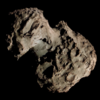astro.wikisort.org - Comet
178P/Hug–Bell is a periodic comet in the Solar System. It was discovered by Northeast Kansas Amateur Astronomers' League members Gary Hug and Graham Bell and is thought to be the first periodic comet to be discovered by amateurs. It was declared a comet less than two days after its initial discovery, after having its course confirmed on previous images.[3]
| Discovery | |
|---|---|
| Discovered by | Gary Hug and Graham E. Bell |
| Discovery date | December 10, 1999 |
| Alternative designations | 1999 X1, 2006 O1 |
| Orbital characteristics A | |
| Epoch | July 7, 2013 |
| Aphelion | 5.405 AU |
| Perihelion | 1.9337 AU |
| Semi-major axis | 3.6993 AU |
| Eccentricity | 0.4730 |
| Orbital period | 7.03 a |
| Inclination | 10.9755° |
| Last perihelion | 2020-Jul-16[1] July 23, 2013[2] July 6, 2006 |
| Next perihelion | 2027-Jun-21 (JPL Horizons) |
Hug-Bell's orbital period is about seven years; its orbit is eccentric, though less so than many comets. Hug-Bell's orbit lies entirely outside the orbit of Mars, but at its aphelion overlaps in solar distance with the orbit of Jupiter. Because it never comes closer to the Sun than about 2 AU, it is never expected to be a very bright comet, with a typical perihelion magnitude of 18-19.[4]
References
- "178P/Hug-Bell Orbit". Minor Planet Center. Retrieved 2014-06-20.
- Syuichi Nakano (2010-04-09). "178P/Hug-Bell (NK 1910)". OAA Computing and Minor Planet Sections. Retrieved 2012-02-25.
- "Winter, Jennifer and Winter, Vic. Comet Hug-Bell Discovery!". ICSTARS Astronomy. Archived from the original on 19 October 2006. Retrieved 2006-10-18.
- "178P/Hug-Bell (1999)". Seiichi Yoshida July 21, 2006. Retrieved 2006-10-18.
External links
- Orbital simulation from JPL (Java) / Horizons Ephemeris
- 178P/Hug-Bell – Seiichi Yoshida @ aerith.net
- 178P/Hug-Bell @ JPL Small-Body Database Browser
На других языках
- [en] 178P/Hug–Bell
[ru] 178P/Хага — Белла
Комета Хага — Белла (178P/Hug–Bell) — короткопериодическая комета из семейства Юпитера, которая была обнаружена 10 декабря 1999 года американскими астрономами Гари Хагом и Грэмом Беллом в обсерватории Фарпоинт, когда они выполняли рутинную работу по поиску астероидов с помощью своего автоматического 12-дюймового телескопа системы Шмидта–Кассегрена и ПЗС-камеры. Она была описана как диффузный объект 18,8 m звёздной величины с небольшим хвостом. Она считается первой кометой, открытой астрономами-любителями. Вскоре комета была обнаружена на более ранних снимках, что позволило рассчитать её орбиту. В результате объект официально был признан кометой всего через два дня после открытия[4]. Комета обладает довольно коротким периодом обращения вокруг Солнца — чуть более 7,0 года.Другой контент может иметь иную лицензию. Перед использованием материалов сайта WikiSort.org внимательно изучите правила лицензирования конкретных элементов наполнения сайта.
WikiSort.org - проект по пересортировке и дополнению контента Википедии

